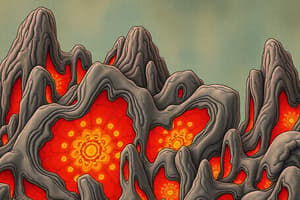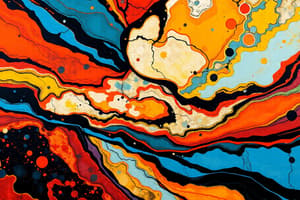Podcast
Questions and Answers
Which of the following processes is essential in the formation of igneous rocks?
Which of the following processes is essential in the formation of igneous rocks?
- Deposition of sediments
- Weathering and erosion
- Application of pressure and temperature to pre-existing rocks
- Cooling and solidification of molten rock (correct)
During fractional crystallization, what property differentiates the separation of crystalline solids?
During fractional crystallization, what property differentiates the separation of crystalline solids?
- Crystal structure
- Density
- Solubility (correct)
- Melting point
Which characteristic is most indicative of an extrusive igneous rock?
Which characteristic is most indicative of an extrusive igneous rock?
- Formation deep within the Earth's crust
- Formation from lava cooling on the Earth's surface (correct)
- High silica content
- Slow cooling process resulting in large crystals
Basaltic rock is characterized by what property?
Basaltic rock is characterized by what property?
What is the primary difference between magma and lava?
What is the primary difference between magma and lava?
Which of the following best describes the 'texture' of a rock?
Which of the following best describes the 'texture' of a rock?
What is the key process involved in cementation?
What is the key process involved in cementation?
Which of the following processes leads to the formation of sediment?
Which of the following processes leads to the formation of sediment?
Which of the following characteristics defines a clastic rock?
Which of the following characteristics defines a clastic rock?
How does increased water content affect the melting point of rocks and minerals?
How does increased water content affect the melting point of rocks and minerals?
Which factor primarily determines whether a magma is classified as basaltic, andesitic, or rhyolitic?
Which factor primarily determines whether a magma is classified as basaltic, andesitic, or rhyolitic?
According to Bowen's reaction series, which mineral is typically the first to form when magma begins to cool?
According to Bowen's reaction series, which mineral is typically the first to form when magma begins to cool?
What is the primary feature of sedimentary rock
What is the primary feature of sedimentary rock
What type of weathering alters the chemical composition of rocks?
What type of weathering alters the chemical composition of rocks?
What is the key characteristic of foliated metamorphic rocks?
What is the key characteristic of foliated metamorphic rocks?
In the context of sedimentary rocks, what does 'porosity' refer to?
In the context of sedimentary rocks, what does 'porosity' refer to?
What type of metamorphism occurs when hot water reacts with rock, altering its chemical and mineral composition?
What type of metamorphism occurs when hot water reacts with rock, altering its chemical and mineral composition?
What is the role of pressure in the formation of metamorphic rocks?
What is the role of pressure in the formation of metamorphic rocks?
Which of the following processes describes lithification?
Which of the following processes describes lithification?
A sedimentary deposit contains particles of all sizes because its particles are dumped in unsorted piles when, for example, a glacier melts or there is a landslide This is an example of?
A sedimentary deposit contains particles of all sizes because its particles are dumped in unsorted piles when, for example, a glacier melts or there is a landslide This is an example of?
Flashcards
Igneous rock
Igneous rock
Rock formed from cooling and solidification of molten rock.
Fractional crystallization
Fractional crystallization
Separating two or more crystalline solids based on differences in solubilities in the same solvent.
Extrusive rock
Extrusive rock
Igneous rock formed from lava cooling and crystalizing on the Earth's surface.
Basaltic rock
Basaltic rock
Signup and view all the flashcards
Granitic Rock
Granitic Rock
Signup and view all the flashcards
Texture (of rock)
Texture (of rock)
Signup and view all the flashcards
Sediment
Sediment
Signup and view all the flashcards
Cementation
Cementation
Signup and view all the flashcards
Clastic
Clastic
Signup and view all the flashcards
Graded bedding
Graded bedding
Signup and view all the flashcards
Cross-bedding
Cross-bedding
Signup and view all the flashcards
Hydrothermal metamorphism
Hydrothermal metamorphism
Signup and view all the flashcards
Porosity
Porosity
Signup and view all the flashcards
Foliated
Foliated
Signup and view all the flashcards
Rock cycle
Rock cycle
Signup and view all the flashcards
Lava
Lava
Signup and view all the flashcards
Lithification
Lithification
Signup and view all the flashcards
Bedding
Bedding
Signup and view all the flashcards
Porosity
Porosity
Signup and view all the flashcards
Foliated (texture)
Foliated (texture)
Signup and view all the flashcards
Study Notes
Igneous Rock Formation
- Igneous rocks originate from the cooling and solidification of molten rock.
- These rocks are composed of minerals containing silicon and oxygen, along with other elements.
- Igneous rocks result when lava or magma cools, allowing minerals to crystallize.
- Lava is essentially magma that has reached Earth's surface.
Composition of Magma
- Igneous rock types depend on magma composition and its mix of molten rock, dissolved gases, and mineral crystals.
- Magma is classified as basaltic, andesitic, or rhyolitic based on silica content.
- Silica impacts the melting temperature of magma and its flow rate.
Magma Formation
- Magma forms through the melting of Earth's crust or mantle.
- Temperature, pressure, water content, and mineral content are four major factors in magma formation.
- The geothermal gradient describes an increase in temperature with depth in Earth's crust.
- Increased pressure raises a rock's melting point; water content decreases it.
Mineral Content and Melting
- Rocks and minerals contain differing water percentages, changing melting points.
- Water content increases can lower melting points.
- Rocks rich in iron and magnesium melt at higher temperatures than those with more silicon.
- Partial melting happens when temperatures do not melt the entire rock, which causes a magma with a different composition.
Bowen's Reaction Series
- N.L. Bowen showed that minerals form predictable patterns as magma cools; this is known as Bowen's reaction series.
- Bowen identified two crystallization patterns or branches.
- The left branch consists of iron-rich minerals that abruptly change as magma cools.
- Feldspars make up the right branch, featuring plagioclase feldspars that change composition continuously during magma cooling.
Mineral Composition and Types of Igneous Rocks
- Intrusive rock cools and crystallizes below Earth's surface.
- Extrusive rock cools and crystallizes on Earth's surface.
- Basaltic rock is dark-colored with low silica content, composed mainly of plagioclase and pyroxene.
- Granitic rock (felsic) is light-colored with high silica content, containing quartz and feldspar.
- Intermediate rocks are between basaltic and granitic in composition.
- Ultrabasic/ultramafic rocks are always dark and contain only iron-rich minerals.
Texture and Formation
- Texture refers to the size, shape, and distribution of crystal grains in the rock.
- Quickly cooled lava forms volcanic glass.
- Porphyritic rocks have large, well-formed crystals in a matrix of finer crystals.
- Vesicular texture indicates a spongy appearance from trapped gas bubbles.
Resources
- Veins of valuable ore deposits are often found within igneous intrusions.
- Pegmatites are veins of large-grained minerals that may contain ores.
- Kimberlites are ultrabasic rocks formed under high pressure and can contain diamonds.
- Olivine is often the first mineral to form as magma cools.
Sedimentary Rock Formation (Weathering and Erosion)
- Sedimentary rocks start as small rock pieces (sediments) moved by water, wind, glaciers, and gravity.
- Weathering breaks down rocks, and erosion transports sediments.
Weathering Types
- Chemical weathering changes rocks chemically through dissolution.
- Physical weathering breaks rocks into fragments without changing their chemical composition.
- Granite eventually decomposes when exposed to chemical and physical weathering.
Erosion and Transport
- Erosion is sediment removal and transport.
- Wind, water, gravity, and glaciers erode materials.
- Eroded fragments are often transported to new locations downhill.
Deposition
- Deposition occurs when transported sediments settle on the ground or at the bottom of water bodies.
- Layers form, with the largest grains settling at the bottom.
Energy of Transporting Agents
- Particles settle in layers of different sizes as water slows down.
- Wind-deposited sediments are fine and well-sorted due to wind carrying only small grains.
- Unsorted deposits occur from glaciers melting or landslides.
Lithification
- Lithification is the process where sediments turn into sedimentary rocks under pressure and temperature.
Compaction and Cementation
- Lithification begins with compaction, squeezing the sediment grains together when overlying sediment increases.
- Cementation occurs as dissolved minerals precipitate from groundwater, gluing sediment grains.
Sedimentary Features (Bedding)
- Bedding, or horizontal layering, is a primary sedimentary rock feature resulting from sediment settling.
- Graded bedding is when particle sizes get heavier and coarser from top to bottom.
- Cross-bedding consists of inclined sediment layers deposited across a horizontal surface.
Angularity
- During sediment transport, angular pieces become rounded as edges break off.
Sedimentary Rocks (Clastic)
- Clastic sedimentary rocks, the most common type, form from loose sediment deposits.
- "Clastic" describes rock and mineral fragments from weathering and erosion.
- These rocks are further classified by particle size.
- Conglomerates are coarse-grained rocks with rounded gravel.
- Breccias are composed of angular, gravel-sized particles.
Sedimentary Rocks (Medium Grained)
- Porosity defines open spaces percentage within a material like rock.
- Sandstone serves as reservoirs for oil, natural gas, and groundwater.
Sedimentary Rocks (Fine Grained)
- Fine-grained clastic rocks are slit- and clay-sized particle sediments.
- Low-porosity fine-grained rocks prevent groundwater and oil movement.
Sedimentary Rocks (Chemical)
- Chemical sedimentary rocks, or evaporites, precipitate from solutions when minerals reach saturation.
- Constant evaporation leads to high salt precipitation.
Sedimentary Rocks (Biochemical)
- Biochemical sedimentary rocks are formed from remains of living organisms.
- Limestone, the most abundant type, comprises calcite.
- Shells of dead organisms form carbonate sediment layers.
- Calcium carbonate precipitates and crystallizes to form limestone during lithification.
Metamorphic Rock Formation
- Metamorphic rocks form upon high temperature and pressure exposure.
- This alters or changes the rocks, but without melting.
- High temperatures come from the earth's heat, and high pressure comes from deep burial or mountain building.
Metamorphic Textures
- Foliated rocks have layers and mineral bands.
- Foliation develops when pressure is applied from opposite directions, causing foliation being perpendicular to the pressure direction
- Nonfoliated rocks consist mainly of blocky crystal-shaped minerals, such as quartzite and marble.
Metamorphism Grades and Types
- Different pressure and temperature combinations result in different grades of metamorphism.
- Metamorphism is classified as low, intermediate, or high grade.
- Regional metamorphism occurs when high temperatures and pressures affect large Earth's crust areas, which results in changes in minerals and rocks.
- Contact metamorphism happens when molten material comes in contact with solid rock at high temperatures and moderate to low pressure.
- Hydrothermal metamorphism occurs when very hot water reacts with rocks to alter its composition near igneous intrusions and active volcanoes.
Rock Cycle
- The rock cycle groups rocks by their formation method.
- Igneous rocks crystallize from magma.
- Sedimentary rocks form from cemented or precipitated sediments.
- Metamorphic rocks form from changes from temperature and pressure.
- Any rock type can transform into another.
Studying That Suits You
Use AI to generate personalized quizzes and flashcards to suit your learning preferences.




